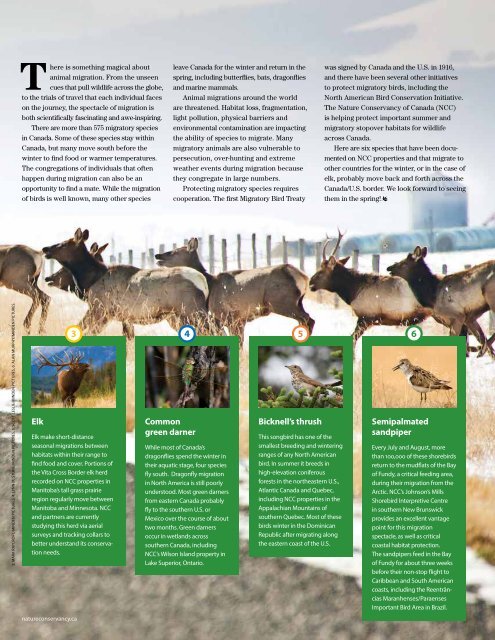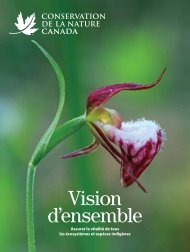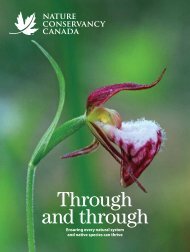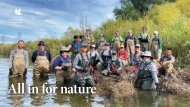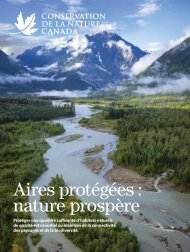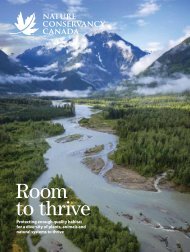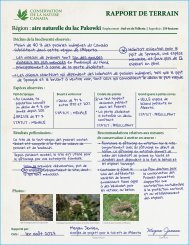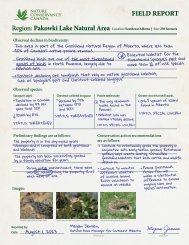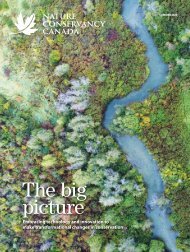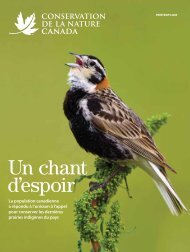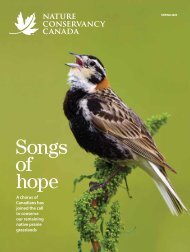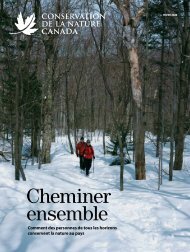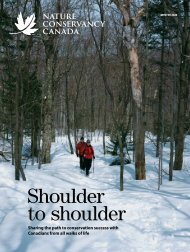Winter 2018 NCC magazine
Create successful ePaper yourself
Turn your PDF publications into a flip-book with our unique Google optimized e-Paper software.
There is something magical about<br />
animal migration. From the unseen<br />
cues that pull wildlife across the globe,<br />
to the trials of travel that each individual faces<br />
on the journey, the spectacle of migration is<br />
both scientifically fascinating and awe-inspiring.<br />
There are more than 575 migratory species<br />
in Canada. Some of these species stay within<br />
Canada, but many move south before the<br />
winter to find food or warmer temperatures.<br />
The congregations of individuals that often<br />
happen during migration can also be an<br />
opportunity to find a mate. While the migration<br />
of birds is well known, many other species<br />
leave Canada for the winter and return in the<br />
spring, including butterflies, bats, dragonflies<br />
and marine mammals.<br />
Animal migrations around the world<br />
are threatened. Habitat loss, fragmentation,<br />
light pollution, physical barriers and<br />
environmental contamination are impacting<br />
the ability of species to migrate. Many<br />
migratory animals are also vulnerable to<br />
persecution, over-hunting and extreme<br />
weather events during migration because<br />
they congregate in large numbers.<br />
Protecting migratory species requires<br />
cooperation. The first Migratory Bird Treaty<br />
was signed by Canada and the U.S. in 1916,<br />
and there have been several other initiatives<br />
to protect migratory birds, including the<br />
North American Bird Conservation Initiative.<br />
The Nature Conservancy of Canada (<strong>NCC</strong>)<br />
is helping protect important summer and<br />
migratory stopover habitats for wildlife<br />
across Canada.<br />
Here are six species that have been documented<br />
on <strong>NCC</strong> properties and that migrate to<br />
other countries for the winter, or in the case of<br />
elk, probably move back and forth across the<br />
Canada/U.S. border. We look forward to seeing<br />
them in the spring!1<br />
3: MARK RAYCROFT/MINDEN PICTURES, 4: LYNN M. STONE/MINDEN PICTURES, 5: SCOTT LESLIE/MINDEN PICTURES, 6: ALAN MURPHY/MINDEN PICTURES.<br />
Elk<br />
Elk make short-distance<br />
seasonal migrations between<br />
habitats within their range to<br />
find food and cover. Portions of<br />
the Vita Cross Border elk herd<br />
recorded on <strong>NCC</strong> properties in<br />
Manitoba’s tall grass prairie<br />
region regularly move between<br />
Manitoba and Minnesota. <strong>NCC</strong><br />
and partners are currently<br />
studying this herd via aerial<br />
surveys and tracking collars to<br />
better understand its conservation<br />
needs.<br />
natureconservancy.ca<br />
3 4 5 6<br />
Common<br />
green darner<br />
While most of Canada’s<br />
dragonflies spend the winter in<br />
their aquatic stage, four species<br />
fly south. Dragonfly migration<br />
in North America is still poorly<br />
understood. Most green darners<br />
from eastern Canada probably<br />
fly to the southern U.S. or<br />
Mexico over the course of about<br />
two months. Green darners<br />
occur in wetlands across<br />
southern Canada, including<br />
<strong>NCC</strong>’s Wilson Island property in<br />
Lake Superior, Ontario.<br />
Bicknell’s thrush<br />
This songbird has one of the<br />
smallest breeding and wintering<br />
ranges of any North American<br />
bird. In summer it breeds in<br />
high-elevation coniferous<br />
forests in the northeastern U.S.,<br />
Atlantic Canada and Quebec,<br />
including <strong>NCC</strong> properties in the<br />
Appalachian Mountains of<br />
southern Quebec. Most of these<br />
birds winter in the Dominican<br />
Republic after migrating along<br />
the eastern coast of the U.S.<br />
Semipalmated<br />
sandpiper<br />
Every July and August, more<br />
than 100,000 of these shorebirds<br />
return to the mudflats of the Bay<br />
of Fundy, a critical feeding area,<br />
during their migration from the<br />
Arctic. <strong>NCC</strong>’s Johnson’s Mills<br />
Shorebird Interpretive Centre<br />
in southern New Brunswick<br />
provides an excellent vantage<br />
point for this migration<br />
spectacle, as well as critical<br />
coastal habitat protection.<br />
The sandpipers feed in the Bay<br />
of Fundy for about three weeks<br />
before their non-stop flight to<br />
Caribbean and South American<br />
coasts, including the Reentrâncias<br />
Maranhenses/Paraenses<br />
Important Bird Area in Brazil.


